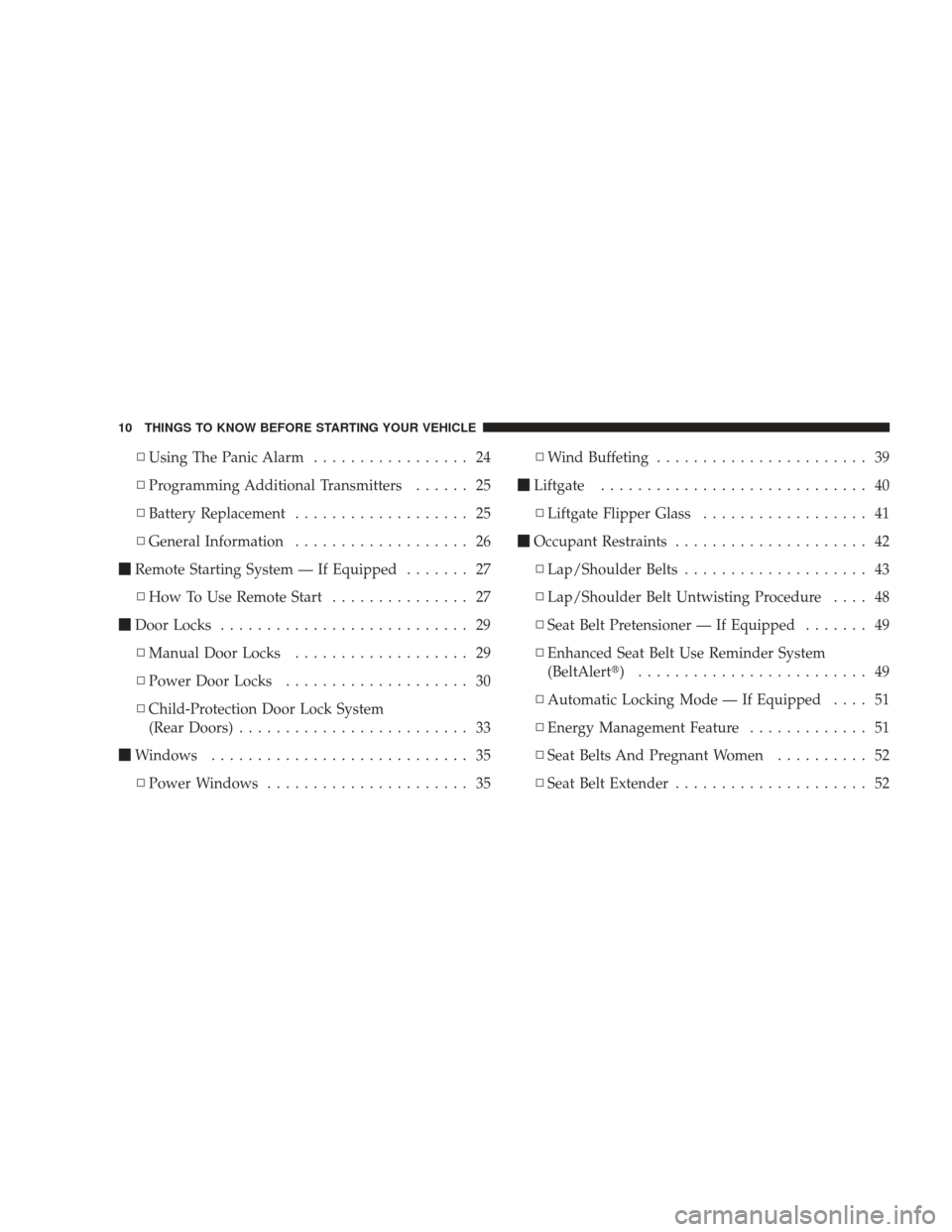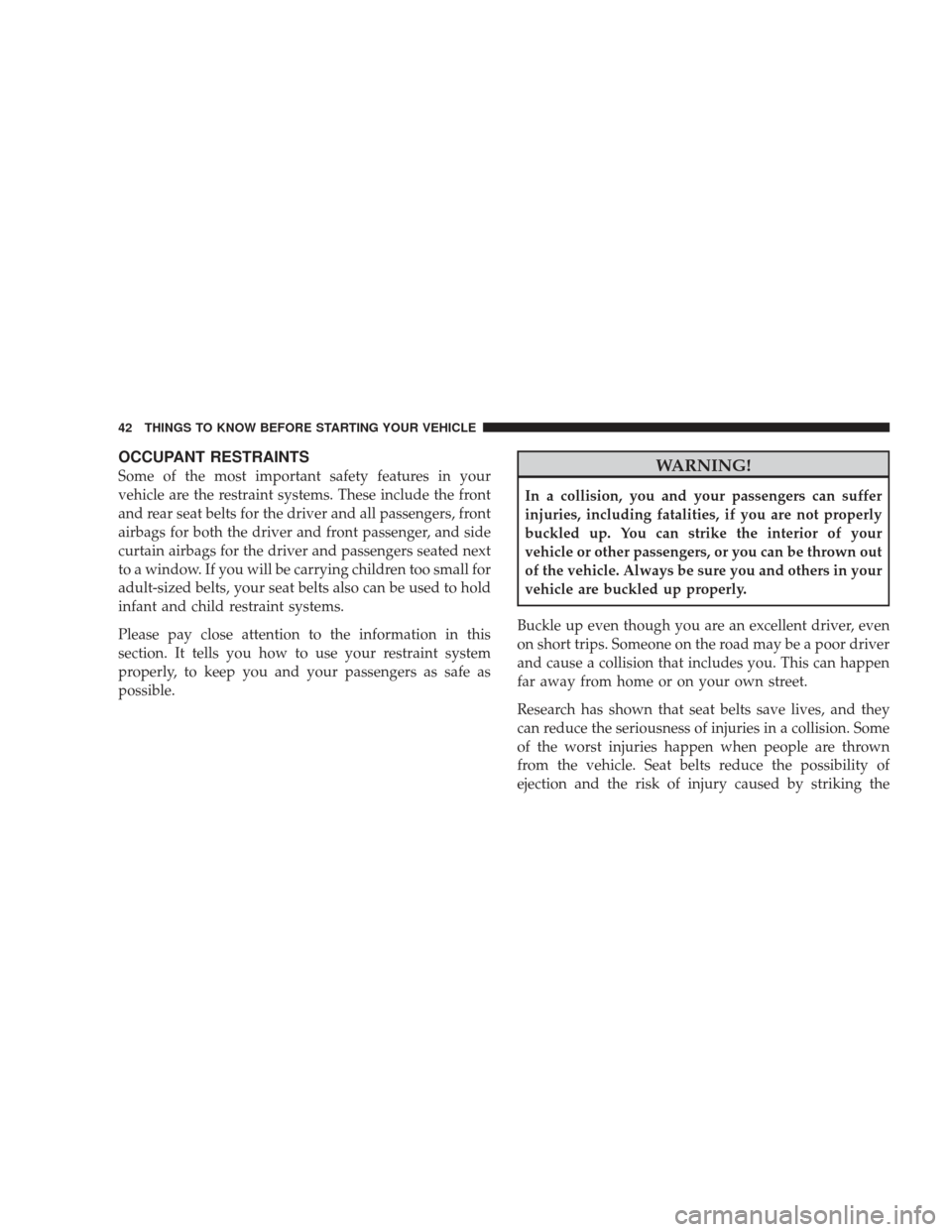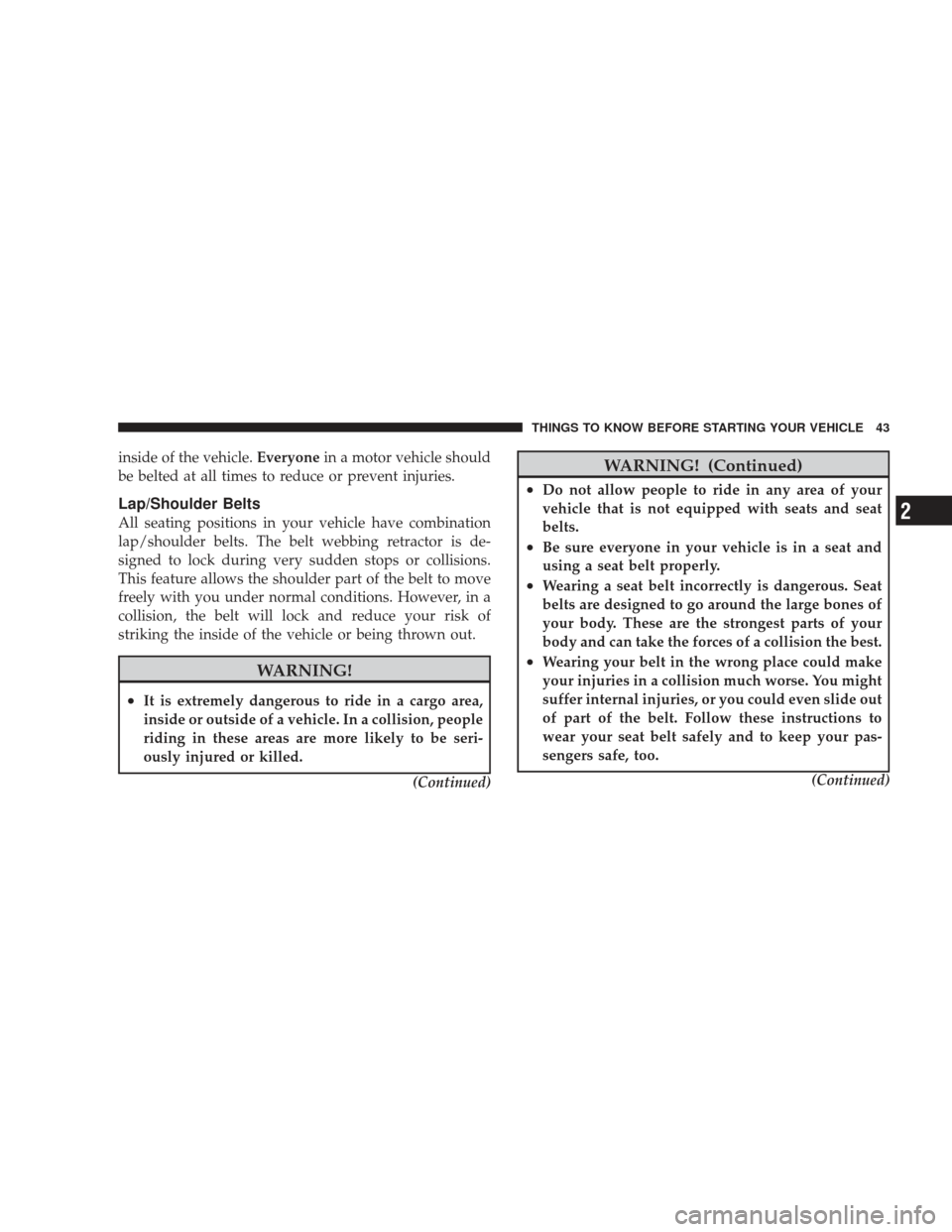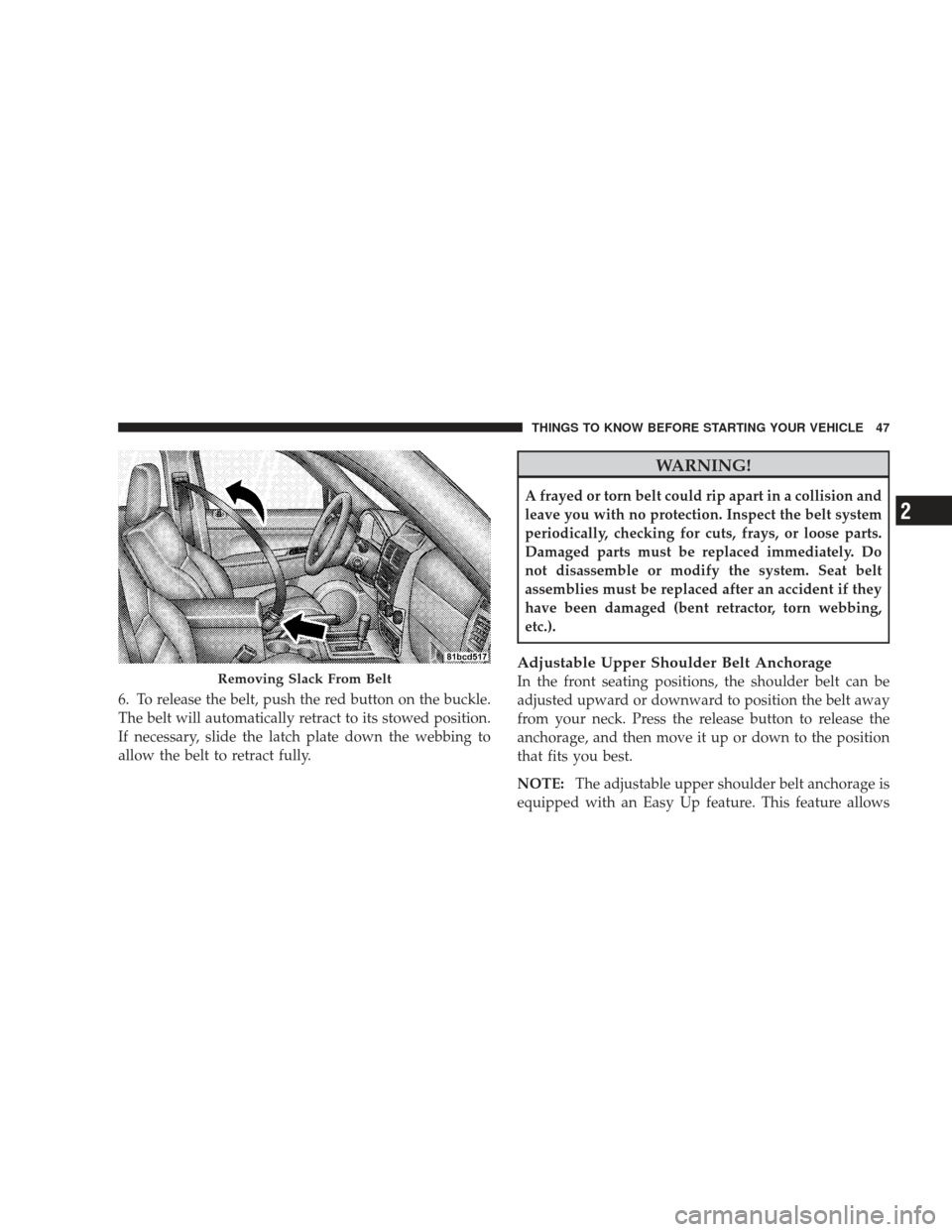Page 7 of 506
Failure to use driver and passenger seat beltsprovided
is a major cause of severe or fatal injury. In fact, the U.S.
government notes that the universal use of existing seat
belts could cut the highway death toll by 10,000 or more
each year and could reduce disabling injuries by two million annually. In a rollover crash, an unbelted person
is significantly more likely to die than a person wearing
a seat belt. Always buckle up.
HOW TO USE THIS MANUAL
Consult the Table of Contents to determine which section
contains the information you desire.
The detailed index at the back of this Owner’s Manual
contains a complete listing of all subjects.
Consult the following table for a description of the
symbols that may be used on your vehicle or throughout
this Owner’s Manual:
Rollover Warning Label
INTRODUCTION 5
1
Page 12 of 506

▫Using The Panic Alarm ................. 24
▫ Programming Additional Transmitters ...... 25
▫ Battery Replacement ................... 25
▫ General Information ................... 26
� Remote Starting System — If Equipped ....... 27
▫ How To Use Remote Start ............... 27
� Door Locks ........................... 29
▫ Manual Door Locks ................... 29
▫ Power Door Locks .................... 30
▫ Child-Protection Door Lock System
(Rear Doors) ......................... 33
� Windows ............................ 35
▫ Power Windows ...................... 35 ▫
Wind Buffeting ....................... 39
� Liftgate ............................. 40
▫ Liftgate Flipper Glass .................. 41
� Occupant Restraints ..................... 42
▫ Lap/Shoulder Belts .................... 43
▫ Lap/Shoulder Belt Untwisting Procedure .... 48
▫ Seat Belt Pretensioner — If Equipped ....... 49
▫ Enhanced Seat Belt Use Reminder System
(BeltAlert�) ......................... 49
▫ Automatic Locking Mode — If Equipped .... 51
▫ Energy Management Feature ............. 51
▫ Seat Belts And Pregnant Women .......... 52
▫ Seat Belt Extender ..................... 52
10 THINGS TO KNOW BEFORE STARTING YOUR VEHICLE
Page 44 of 506

OCCUPANT RESTRAINTS
Some of the most important safety features in your
vehicle are the restraint systems. These include the front
and rear seat belts for the driver and all passengers, front
airbags for both the driver and front passenger, and side
curtain airbags for the driver and passengers seated next
to a window. If you will be carrying children too small for
adult-sized belts, your seat belts also can be used to hold
infant and child restraint systems.
Please pay close attention to the information in this
section. It tells you how to use your restraint system
properly, to keep you and your passengers as safe as
possible.WARNING!
In a collision, you and your passengers can suffer
injuries, including fatalities, if you are not properly
buckled up. You can strike the interior of your
vehicle or other passengers, or you can be thrown out
of the vehicle. Always be sure you and others in your
vehicle are buckled up properly.
Buckle up even though you are an excellent driver, even
on short trips. Someone on the road may be a poor driver
and cause a collision that includes you. This can happen
far away from home or on your own street.
Research has shown that seat belts save lives, and they
can reduce the seriousness of injuries in a collision. Some
of the worst injuries happen when people are thrown
from the vehicle. Seat belts reduce the possibility of
ejection and the risk of injury caused by striking the
42 THINGS TO KNOW BEFORE STARTING YOUR VEHICLE
Page 45 of 506

inside of the vehicle.Everyonein a motor vehicle should
be belted at all times to reduce or prevent injuries.
Lap/Shoulder Belts
All seating positions in your vehicle have combination
lap/shoulder belts. The belt webbing retractor is de-
signed to lock during very sudden stops or collisions.
This feature allows the shoulder part of the belt to move
freely with you under normal conditions. However, in a
collision, the belt will lock and reduce your risk of
striking the inside of the vehicle or being thrown out.
WARNING!
•It is extremely dangerous to ride in a cargo area,
inside or outside of a vehicle. In a collision, people
riding in these areas are more likely to be seri-
ously injured or killed.
(Continued)
WARNING! (Continued)
•Do not allow people to ride in any area of your
vehicle that is not equipped with seats and seat
belts.
•Be sure everyone in your vehicle is in a seat and
using a seat belt properly.
•Wearing a seat belt incorrectly is dangerous. Seat
belts are designed to go around the large bones of
your body. These are the strongest parts of your
body and can take the forces of a collision the best.
•Wearing your belt in the wrong place could make
your injuries in a collision much worse. You might
suffer internal injuries, or you could even slide out
of part of the belt. Follow these instructions to
wear your seat belt safely and to keep your pas-
sengers safe, too.(Continued)
THINGS TO KNOW BEFORE STARTING YOUR VEHICLE 43
2
Page 46 of 506
WARNING! (Continued)
•Two people should never be belted into a single
seat belt. People belted together can crash into one
another in an accident, hurting one another badly.
Never use a lap/shoulder belt or a lap belt for more
than one person, no matter what their size.
Lap/Shoulder Belt Operating Instructions
1. Enter the vehicle and close the door. Sit back and
adjust the seat.
2. The seat belt latch plate, located on the B-Pillar is just
above your seatback. Grasp the latch plate and pull out
the belt. Slide the latch plate up the webbing as far as
necessary to make the belt go around your lap.3. When the belt is long enough to fit, insert the latch
plate into the buckle until you hear a “click.”
Latch Plate
44 THINGS TO KNOW BEFORE STARTING YOUR VEHICLE
Page 47 of 506
WARNING!
•A belt that is buckled into the wrong buckle will
not protect you properly. The lap portion could ride
too high on your body, possibly causing internal
injuries. Always buckle your belt into the buckle
nearest you.
• A belt that is too loose will not protect you as well.
In a sudden stop, you could move too far forward,
increasing the possibility of injury. Wear your seat
belt snugly.
• A belt that is worn under your arm is very danger-
ous. Your body could strike the inside surfaces of the
vehicle in a collision, increasing head and neck
injury. A belt worn under the arm can cause internal
injuries. Ribs aren’t as strong as shoulder bones.
Wear the belt over your shoulder so that your stron-
gest bones will take the force in a collision.
(Continued)
Latch Plate To Buckle
THINGS TO KNOW BEFORE STARTING YOUR VEHICLE 45
2
Page 48 of 506

WARNING! (Continued)
•A shoulder belt placed behind you will not protect
you from injury during a collision. You are more
likely to hit your head in a collision if you do not
wear your shoulder belt. The lap and shoulder belt
are meant to be used together.
4. Position the lap belt across your thighs, below your
abdomen. To remove slack in the lap belt portion, pull up
a bit on the shoulder belt. To loosen the lap belt if it is too
tight, tilt the latch plate and pull on the lap belt. A snug
belt reduces the risk of sliding under the belt in a
collision.
WARNING!
• A lap belt worn too high can increase the risk of
injury in a collision. The belt forces won’t be at the
strong hip and pelvic bones, but across your abdo-
men. Always wear the lap part of your seat belt as
low as possible and keep it snug.
• A twisted belt can’t do its job as well. In a collision,
it could even cut into you. Be sure the belt is straight.
If you can’t straighten a belt in your vehicle, take it to
your authorized dealer and have it fixed.
5. Position the shoulder belt on your chest so that it is
comfortable and not resting on your neck. The retractor
will withdraw any slack in the belt.
46 THINGS TO KNOW BEFORE STARTING YOUR VEHICLE
Page 49 of 506

6. To release the belt, push the red button on the buckle.
The belt will automatically retract to its stowed position.
If necessary, slide the latch plate down the webbing to
allow the belt to retract fully.
WARNING!
A frayed or torn belt could rip apart in a collision and
leave you with no protection. Inspect the belt system
periodically, checking for cuts, frays, or loose parts.
Damaged parts must be replaced immediately. Do
not disassemble or modify the system. Seat belt
assemblies must be replaced after an accident if they
have been damaged (bent retractor, torn webbing,
etc.).
Adjustable Upper Shoulder Belt Anchorage
In the front seating positions, the shoulder belt can be
adjusted upward or downward to position the belt away
from your neck. Press the release button to release the
anchorage, and then move it up or down to the position
that fits you best.
NOTE:The adjustable upper shoulder belt anchorage is
equipped with an Easy Up feature. This feature allowsRemoving Slack From Belt
THINGS TO KNOW BEFORE STARTING YOUR VEHICLE 47
2